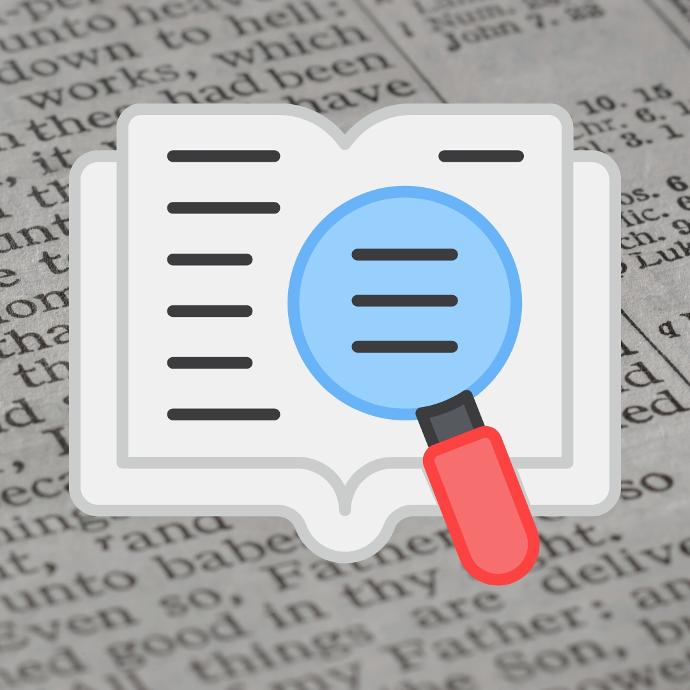Previous Next
12 And to the angel of the church in Pergamum write; These things said he which has the sharp sword with two edges;
13 I know your works, and where you dwell, even where Satan’s seat is: and you hold fast my name, and have not denied my faith, even in those days wherein Antipas was my faithful martyr, who was slain among you, where Satan dwells.
14 But I have a few things against you, because you have there them that hold the doctrine of Balaam, who taught Balac to cast a stumbling block before the children of Israel, to eat things sacrificed to idols, and to commit fornication.
15 So have you also them that hold the doctrine of the Nicolaitans, which thing I hate.
16 Repent; or else I will come to you quickly, and will fight against them with the sword of my mouth.
17 He that has an ear, let him hear what the Spirit said to the churches; To him that overcomes will I give to eat of the hidden manna, and will give him a white stone, and in the stone a new name written, which no man knows saving he that receives it.
Drawing Connections
In our last study, we saw how the church in Pergamum was situated in a perilous location, where pagan worship and Roman rule were deeply intertwined, making it challenging to remain faithful to the pure truth of the Gospel. The temptation to conform to pagan practices to avoid persecution was strong, leading to a life of deception. False teachers were causing division, but Jesus, with the sword of His Word, warned of impending judgment. In a city where Satan had his throne, Jesus brought the powerful sword of truth to keep His followers on the path of righteousness.
If you have been following all our studies on the seven churches, you have noticed that we have been dividing each one in two parts. In order to understand the letter, its format and its prophetic application that we cover in Part 2, we first need to understand who were the people receiving the message, what life was like for them. This way we can understand why and how the message made sense to the first-century Christian from that city. Only then we can draw a parallel and apply the message for us today. If you haven't read Part 1 yet, check out study #17 and then come back here. Let's now go over the second part of this study on the third of the seven churches, Pergamum.
Part 1 Part 2
PART 2
Closer Look
*** Recipient -> "To the Angel of the Church in Pergamum" ***: Once again, the letter is addressed to the leader of the church, but applicable to all the members. Please see the comments in study #9, #12, and #14.
*** Sender -> “he which has the sharp sword with two edges” ***: As we saw in study #9, Jesus’s sword is His word, which is sharper than anything else (Hebrews 4:12). It is no surprise that to the church located in the intellectual center of Asia, where the power of reason and thought reigned, and where the seat of the father of lies was (John 8:44), Jesus comes with His mighty and powerful sword of His Word, the truth. That is how He will defend His people: with the truth.
*** Assessment -> "I know…” ***: Jesus knows firsthand what the church is going through:
- Works: Christians in Pergamum faced persecution. They lived in a society that practiced paganism to the point where Jesus considered it to be the place where Satan dwells. Despite that, the members of the church decided to remain in Pergamum and bear witness for Christ, ministering to the people there.
- Faith: Most members of the church were determined to remain faithful even to the point of death, like Antipas. Though we know little else about him, Jesus highlights the most important aspect of Antipas’ choice—perhaps the only thing that truly matters. Jesus considers Antipas to be not just a witness, but a faithful one. A witness to the truth of God. Jesus not only knows his name, but He also knows Antipas’ heart and sincerity. In the book of Revelation, Jesus Himself is called the faithful witness (Revelation 1:5; Revelation 3:14). Antipas had developed such a close relationship with Jesus, that he was consistent (or faithful) with his witnessing, just like Jesus was and still is. Christ elevates His faithful servants, and gives them His own title. They share this unity with Christ. Verse 13 gives us the idea of how the rest of the church reacted to the death of Antipas. They did not run away scared. They were still holding fast the name of Jesus. When Antipas was alive, and even at the time of his death, the church members did not deny their faith in Christ.
- Problem: The first issue is that the Pergamum church is in a very dangerous place: where Satan has his throne. Jesus gives emphasis to this fact. He mentioned it twice in the letter (verse 13). This is not necessarily a problem in the church, but it is a problem for the church. This makes ministering in Pergamum that much harder. The beliefs of the Christians were in direct opposition to the pagan beliefs of their society. When Christians aren’t firmly and well rooted in their faith in Jesus, it is easier to pluck people out of the church with deceiving doctrines. But when Christians allow themselves to be strongly rooted in the love of Jesus, nothing can separate them from Him (Romans 8:36-39). The spiritual instability of some of the members was the cause of the initial rift in the church. It is possible that some time after Antipas’ death people became more afraid of the consequences they would face by choosing not to participate in their civic duties of emperor worshiping. The fact is that we do not know the exact point when some of them started following the teachings Balaam and of the Nicolaitans. However, the pressures the members of the church were living under likely made them question their faith and start adapting to the false teachings of a compromised Gospel.
*** Appeal -> “Repent; if not, there will be war with His sword against the false teachers” ***: The people following the false teachings are called to repent. Believing in such false doctrines is something so serious that it warrants repentance. That’s because they knew better. They had the truth, and still chose to follow different and more “convenient” philosophies. The war that Jesus and His children fight is not physical. 2 Corinthians 10:3-5 says: “For though we live in the world, we do not wage war as the world does. The weapons we fight with are not the weapons of the world. On the contrary, they have divine power to demolish strongholds. We demolish arguments and every pretension that sets itself up against the knowledge of God, and we take captive every thought to make it obedient to Christ.” We are fighting a battle between the truth of God and the lies of Satan. We already know how it is going to end. Jesus' sword will prevail, and the false teachers will not stand a chance. Jesus will come quickly. And when He comes, His sword will set His people free, and will at the same time bring judgment on the ones who choose to believe in something different from His testimony.
*** Call to hear the Spirit -> The Spirit says to the churches ***: The message of “repent from altering God’s teachings” was to be heard by all churches. There are no excuses not to hear this call. Please see the notes on study #14.
*** Promise -> To the one who overcomes ***: The one who overcomes receives 3 promises: hidden manna, a white stone, and a new name engraved on the white stone.
- Hidden Manna: Manna was the white bread sent from Heaven to feed the Israelites while in the wilderness (Exodus 16:11-16, 31-35). It appeared on the ground every morning, except on the Sabbath. Manna would go bad if kept from one day to the next, except on Fridays, when people were instructed to gather enough for two days (Exodus 16:21-24). God told Moses to keep a bowl of manna for the following generations, as evidence of His care. And so, Aaron placed the bowl of manna inside the Ark of the Covenant, along with the Ten Commandments (Exodus 16:32-34). This Manna, however, did not go bad (it was kept for “the generations to come”), even though it was being stored for a long time, hidden inside a box, in the desert. God’s people were asked to eat the white bread, so they could live and be sustained in the wilderness. In John 6:28-40, we see that in a similar way, the followers of Christ are also asked to eat from the true Bread of Life (Jesus), whom God sent from Heaven to give life to the world. Colossians 2:2-4 says: “My goal is that they may be encouraged in heart and united in love, so that they may have the full riches of complete understanding, in order that they may know the mystery of God, namely, Christ, in whom are hidden all the treasures of wisdom and knowledge. I tell you this so that no one may deceive you by fine-sounding arguments.” In this verse we see that “all treasures of wisdom and knowledge” are hidden in Christ. We are called to eat from the Word of God so we are not deceived by “fine-sounding” false arguments. We are called to feast in the truth, as opposed to eating from the “food” offered to idols (false teachings). Ephesians 5:25-32 talks about the relationship between Christ and His church, comparing it to the pure connection a husband must have with his wife. Ephesians 5:27 says the church has to be blameless. In this way, we can understand that Jesus is talking about the church committing adultery by practicing fornication (Revelation 2:14) with the false doctrines. Ephesians 5:26 says that Jesus makes the church holy when “cleansing her by the washing with water through the word”. This means that through the truth that is contained (or hidden) in Jesus, He cleanses and sanctifies His church.
- White Stone: there are many views on what exactly the white stone symbolizes. No single interpretation appears to be fully complete. Perhaps we need to consider all of them in order to get a more complete picture of this concept. 1) Stones in a trial: in John’s time, it was customary to have the jurors vote for acquittal or conviction using a white or a black stone. If a black stone was cast, then the defendant would be condemned. If a white stone was cast, then he would be absolved from all charges. 2) Tessera Hospitalis: this was a white stone given to winning athletes or gladiators. A nobleman could choose to send the champion a white stone with the nobleman’s name engraved on it. With this stone, the winner gained access to the post-game festivities. 3) The Living Stone: Jesus is not only the Living Bread, but also the Living Stone (1 Peter 2:4-8), who was rejected, but who became the cornerstone. Christ is the rock that gives people the spiritual drink (1 Corinthians 10:4). The Lord is the Rock Eternal (Isaiah 26:4), on whom we should securely build our house (Luke 6:47-49). He is the Rock not cut from human hands that will bring an end to all the earthly kingdoms (Daniel 2:44-45). Jesus is the engraved stone that can remove sin from the land in a single day (Zechariah 3:9).
- Secret name on the stone: verse 17 says that only the one who receives this stone will know which name is engraved on it. Revelation 19:12 says Jesus “has a name written on him that no one knows but he himself”. As we can see, no matter how we look at this stone, all the different interpretations of the white stone point to Jesus. He is the rock that bears a name that no one else knows. But the next verse, Revelation 19:13, mentions a known name of Jesus: the Word of God. Jesus himself will give the one who overcomes a new name, or in other words, a new definition of who the overcomer is. It is not up to the overcomer to determine what the new name is. Christ is the one who gives this name. It is up to the Savior to determine. But the Savior Himself also has a name only known to Himself. And just as it was with Antipas, the restored state of the overcomer will resemble Christ, who is “called faithful and true” (Revelation 19:11).
Manna, stone set, and
a name
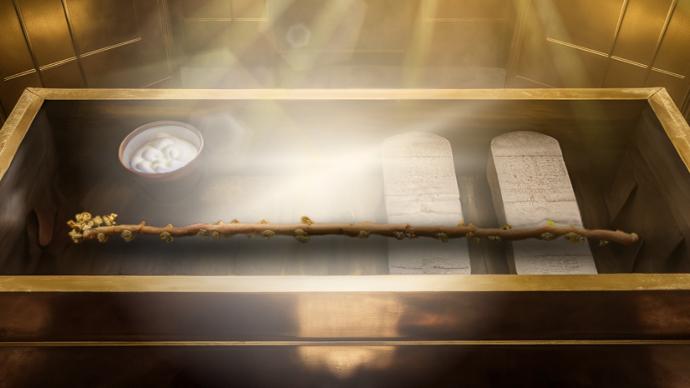
© Hello-Bible - 2024
We can understand that the one who overcomes will receive the Bread of Life: Jesus Himself. The overcomer will no longer eat from strange, false foods, but will eat from the truth of God, Jesus’ testimony. At the cross, Jesus took to Himself all the black stones of condemnation, and replaced them with white stones of saving grace. Christ took the sinner’s name for Himself and gave him His own, so the overcomer can come before the throne of God as a pure and renewed person by the blood of the Son. The one who overcomes now carries on his record the name of Jesus instead of his own. The one who overcomes is now free to enter the festivities of the wedding supper of the Lamb (Revelation 19:9).
*** Church history view and prophetic application ***: The prophetic view of this church fits the time between 313 AD and 538 AD. As we saw in the previous church of Smyrna, up to the year 313 persecution was extremely intense. But, in that year, the Roman Emperor Constantine played an important role in the issuing of the Edict of Milan. This edict was an agreement that included a change in the policy towards Christians. The decree called for tolerance of Christians, and made Christianity a legal status. It did not make it the official religion of the Empire, but it put an end to the cruel persecutions. Constantine was worried about the stability of the Empire and the exponential growth of the Christians. Therefore, historians do not generally consider Constantine to have been a truly converted person. The document states the reason why all of these provisions regarding Christians should be established, stating that “public order could be secured”.
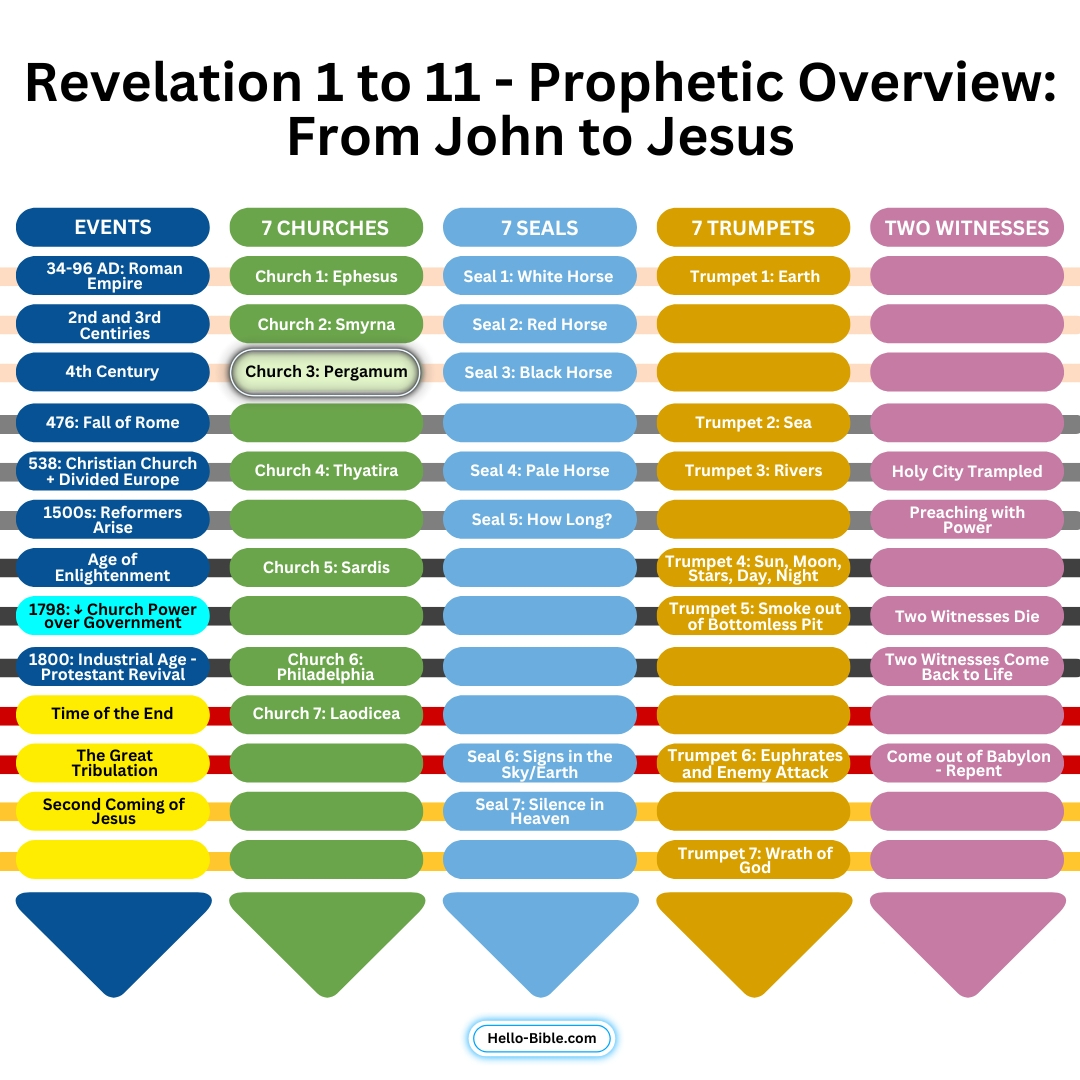
© Hello-Bible - 2024
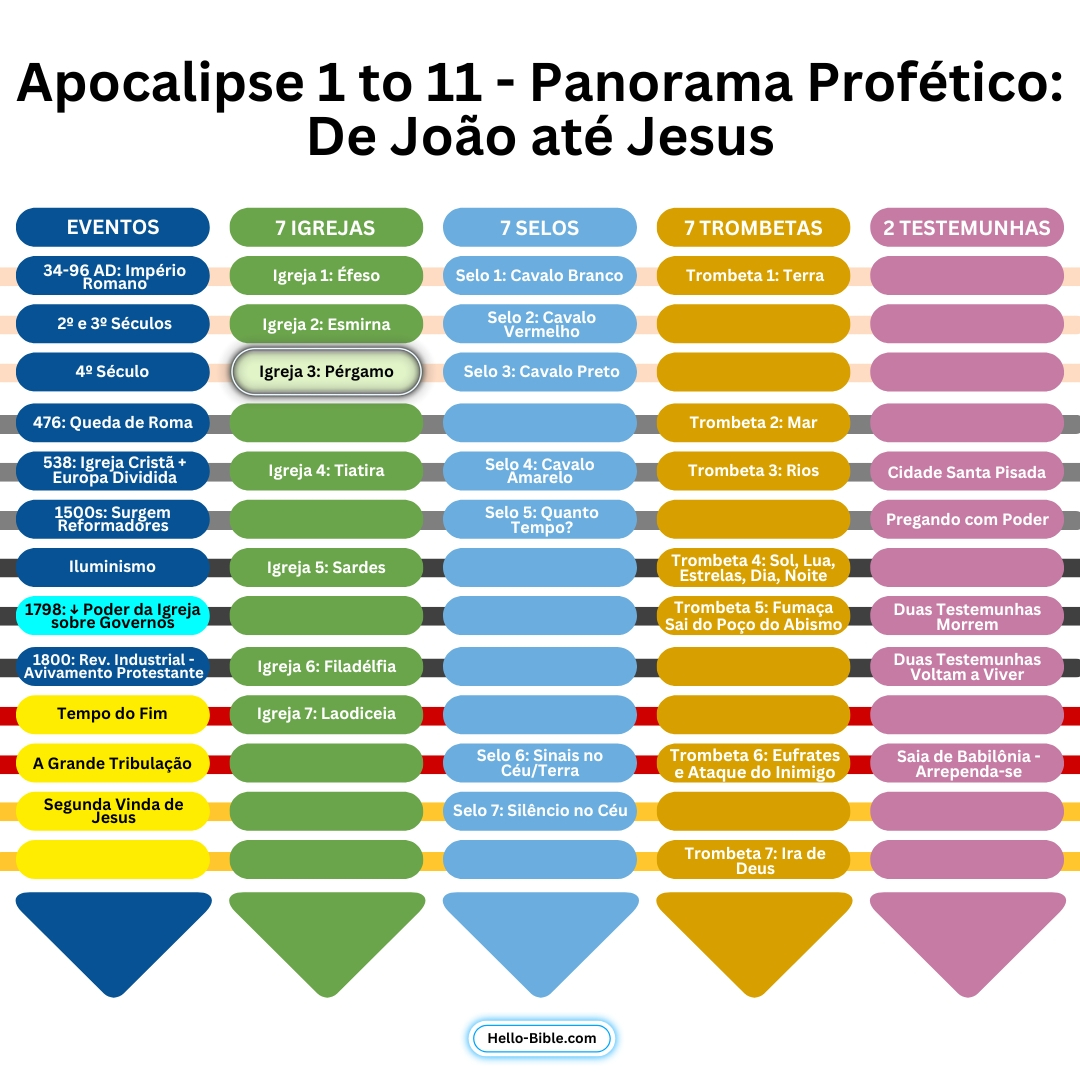
© Hello-Bible - 2024
Constantine actually did not get baptized until near the end of his life, in 337 AD. But while Constantine was alive, he summoned the First Council of Nicaea, which was an ecumenical council with the objective of defining the norms of the church. Constantine was originally a sun worshiper, and even after his alleged conversion to Christianity in 312-313 AD, he continued engaging in pagan practices, and enacted a law that altered original Bible principles regarding worship. He introduced false ideas, and led the people in a path contrary to God’s Word (Exodus 20:8-11). He passed this law in 322 AD, and it is referred to as the edict of Constantine:
“On the venerable Day of the Sun let the magistrates and people residing in cities rest, and let all workshops be closed. In the country, however, persons engaged in agriculture may freely and lawfully continue their pursuits: because it often happens that another day is not so suitable for grain sowing or for vine planting: lest by neglecting the proper moment for such operations the bounty of heaven should be lost."
At the Council of Laodicea, circa 364 AD, the church passed a new canon (Canon 29), which commanded followers to do exactly the opposite of what God had said in Exodus 20:8. Canon 29 says:
“Christians must not judaize by resting on the Sabbath, but must work on that day, rather honoring the Lord’s Day; and, if they can, resting then as Christians. But if any shall be found to be judaizers, let them be anathema from Christ."
The Canons of the Synod of Laodicea
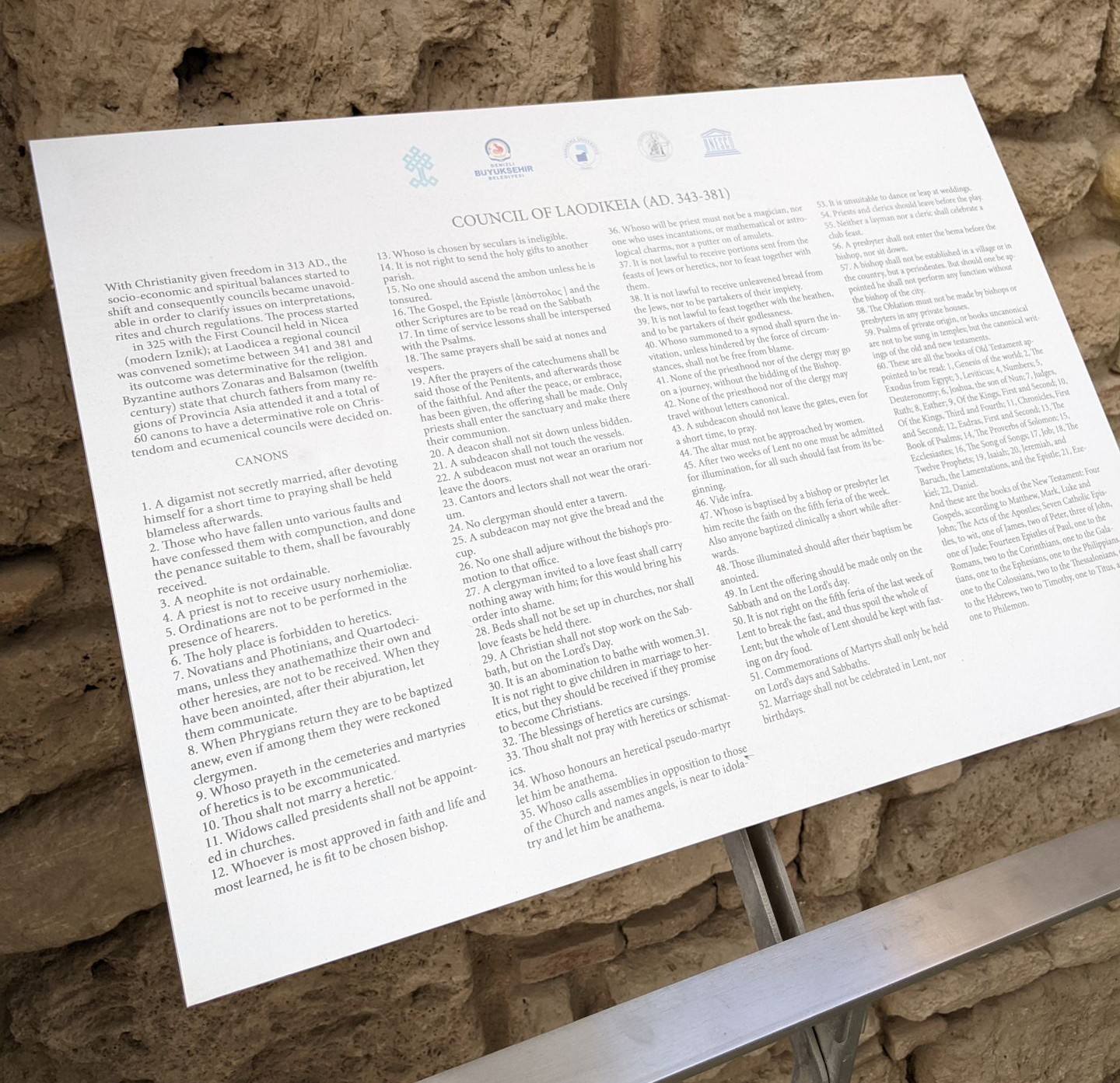
Attribution: TwainSplains, CC BY-SA 4.0, via Wikimedia Commons - Original here
The Edict of Thessalonica, issued in 380 AD, is the document that made Christianity the official religion of the Roman Empire. The end of this phase is about 538 AD, which marked the decline of the Western Roman Empire, and the dawn of the Middle Ages. The year 538 AD marked a crucial turning point in the decline and transformation of the Roman Empire, as it shifted from a pagan entity to one heavily influenced by the Christian Church.
Overview
The message to the church in Pergamum is a very powerful one. Jesus is showing His followers that the truth is what sets them free from the false teachings permeating the minds of some of the members. Jesus warns His children against false teachers, who will try to deceive many. Both the teachings of Balaam and the Nicolaitans point to the eating of foods sacrificed to idols. And here Jesus is asking that His people eat from the true Bread of Life instead. In John 8:42-47, we read a passage where the Pharisees were challenging Jesus, saying God was their father: “Jesus said to them, If God were your Father, you would love me, for I have come here from God. I have not come on my own; God sent me. Why is my language not clear to you? Because you are unable to hear what I say. You belong to your father, the devil, and you want to carry out your father’s desires. He was a murderer from the beginning, not holding to the truth, for there is no truth in him. When he lies, he speaks his native language, for he is a liar and the father of lies. Yet because I tell the truth, you do not believe me! Can any of you prove me guilty of sin? If I am telling the truth, why don’t you believe me? Whoever belongs to God hears what God says. The reason you do not hear is that you do not belong to God.” Belonging to God is the only way we will be able to “hear what the Spirit says to the churches”. The promises to the overcomer are clear signs that the winner belongs to God, and is able to participate in the Heavenly banquet, because the blood of Jesus cleansed him from sin.
Previous Next
